Amazing facts about the National symbols of India
National symbols of India
(1) National Flag:-
The national flag of India is a tricolor which is made up of special and precious colors in which dark saffron color is at the top and white color in the middle and green color at the bottom.
In which the saffron color is the symbol of India's strength, intelligence, and courage and the white color in the middle is the symbol of truth and peace, in which a circle is made in which 24 spokes are used.
This wheel has been taken from the wheel on the Ashoka Pillar of Sarnath which is also called Dharma Chakra and the green color at the bottom of this national flag is a symbol of growth, fertility, and auspiciousness. The size of the tricolor is equal to 3: 2 in length and width.
And this national flag tricolor was made by Shri Pingali Venkayya Ji and this tricolor is the pride of the people of India which he keeps in his heart. This precious tricolor was adopted in the Constitution of India on 22 July 1947.
(2) National language of India:-
There is no national language of our country India, but the Government of India has given the states of India the right to choose their own official language, every state can choose its own language according to its requirement.
But India has given place to about 24 languages in the country as the official language they can choose and the Government of India has given place to Hindi and English language in the official functioning of this language.
(3) National bird of India:-
The national bird of India is the peacock, which is very beautiful and attractive in appearance. This peacock has a thin neck, which is long and dark blue in color. This peacock has a white spot under its eyes. It is larger than the Narmada peacock. becomes colorful.
Peacocks have a bunch of more than 200 feathers and which is quite adorable. The female peacock is brown in color and the peacock has a bunch of feathers that dance in the rainy season by spreading its beautiful feathers because of its special nature. It has been declared the national bird of India.
(4) National flower:-
The national flower of India is the lotus, which is called nilambu Lusi para get to earn in English, which is the symbol of the purity of India. The Lotus flower is mentioned and used in auspicious works since ancient times.
And from India's ancient history and art to culture, this Indian flower has been given a special status, due to which the lotus flower is the national flower of India.
(5) National fruit of India:-
India's national fruit is the mango, which is called Magni Indica in the English language. Along with being fruitful, this fruit is also wonderful in taste. This fruit is grown in tropical countries.
Vitamins A, C, and D are found in this fruit. This fruit is used as a pickle when raw and as a flavor and nutrient when cooked. More than 100 varieties of this type of fruit are found.
As you will see everywhere, the praise of this fruit has been mentioned by the poet Kalidas in his songs. The taste of this fruit was so delicious that the Mughal emperor planted about 10,00,000 mango plants in Akbar's Bihar Darbhanga garden and later today This area is known as Lakhibaug.
Alexander also tasted this fruit at this moment and Chinese traveler Van Song also kept this fruit, because of so many qualities this fruit is called the national fruit of India.
(6) National tree of India:-
The banyan tree is given a special status in India. The name of this banyan tree in English is Ficus bengaliensis. While hanging the branches of this tree, at one time these branches enter the ground and take the form of roots.
And it joins again to form a new stem and branches, if you apply the milk that comes out of the stem of this banyan tree to your hair, then your hair will become hard like a lock, the age of this banyan tree is also thousand. Happens for years.
And this tree is so big that even today meetings are held under it, meetings are held by the sarpanch in the village or on some office matter, and this tree is used to solve any problem under this tree.
This tree is worshiped in the religion of Hindus, who wants to be considered very sacred, due to these special qualities, this tree is considered a national tree.
(7) National Anthem of India:-
The National Anthem of India was written by the late poet Rabindranath Tagore and is sung on major occasions in India.
This song is sung on Independence Day, Republic Day, and other patriotic songs. This song is sung in contemporary respect or song:- "Jana Gana Mana"
The national anthem of India is:
भारत का राष्ट्रगान है:
जनगणमन-अधिनायक जय है भारतभाग्यविधाता!
पंजाब सिंधु गुजरात मराठा द्राविड़ उत्कल बंग
विंध्य हिमाचल यमुना गंगा उच्छलजलधितरंग
तब शुभ नामे जागे, तब शुभ आशिष मागे,
गाहे तब जयगाथा।
जनगणमंगलदायक जय हे भारतभाग्यविधाता!
जय है, जय हे, जय हे, जय जय जय जय हे।।
"Jai Hai Bharat Bhagya Vidhaata!
Punjab Indus Gujarat Maratha Dravidian Utkal Bang
Vindhya Himachal Yamuna Ganga Uchhaljaldhitrang
Then auspicious names wake up, then auspicious blessings are sought,
Gahe then Jayagatha.
People's auspicious Hail India, the bestower of fortune!
Hail Hail Hail Hail Hail Hail Hail Hail Hail"
"janaganaman-adhinaayak jay hai bhaaratabhaagyavidhaata! panjaab sindhu gujaraat maraatha draavid utkal bang vindhy himaachal yamuna ganga uchchhalajaladhitarang tab shubh naame jaage, tab shubh aashish maage, gaahe tab jayagaatha. janaganamangaladaayak jay he bhaaratabhaagyavidhaata! jay hai, jay he, jay he, jay jay jay jay he.."
(8) National Animal of India:-
The Tiger, the national animal of India, is also called a leopard, which is made of black stripes, is very agile and powerful, and is very fast in running.
They will be seen all over the country except in the North Eastern region - Bengal, you will definitely see this thing in Bangladesh, Bhutan, and Nepal, but due to some poaching, the population of these tigers is decreasing day by day.
Due to this, the Government of India has taken measures for the protection of tigers.
square kilometer area where tigers can live freely.
(9) National river of India:-
India's national river is called Ganga, which covers a distance of 2510 kilometers through the valleys and plains in the country of India. This river emerges from the Gangotri glacier of the Himalayas and joins many rivers through the valleys.
These rivers originate from Son, Yamuna, Alaknanda, and Gomti, Kosi, and Ghaghra rivers. The expansion area of this river is very wide and there is a population of 10 lakh people living in the course of this river Ganga.
And dams have been built on the river Ganges, one dam is built in Farakka and the other dam is built in Haridwar. India's national aquatic animal called the dolphin is also found in the river Ganges. The one who is a Sankalp Sankatlpan Jeev.
River Ganga is a holy river for Hindus, on whose ghats, programs of worship, or religious events are organized at many religious places. Religious places of river Ganga like- Haridwar, Varanasi, and Prayagraj are such religious places.
Where programs of worship are done and Ganga is considered to be the most sacred river in the country of India, worshiped as Ganga Mata on which a religious song has also been made which is:-
"Ganga Maiya O Ganga Maiya, if you believe then I am Ganga Maa, if you don't believe then the water flows"
A song has been composed, it is a religious holy song, many such songs have been composed and finally, this river Ganges merges into the sea in the Bay of Bengal, due to these qualities it is called the national river of India.
(10) National aquatic animal of India:-
India's national aquatic animal is a dolphin fish that lives in sweet water, this fish is made for sweet and pure water only, this fish has small eyes which are like a lens that detect the direction of light in its path. I do.
The English name of this fish is pletenista. This fish has a long mouth with upward and downward teeth which helps in eating small animals and fishes. These fishes move in the river with a fin along the substrate direction. Keeps swimming
The forehead of this fish is straight and flat from the front. The color of these fish is light-status and brown in color. Their skin is thick. This female fish is thicker than the male fish. This fish makes a sound while breathing in the river. This fish is a mammal that is found in clean water. This fish is found in Nepal, Bangladesh, Bhutan, and India.
You will find this fish in the Meghna, Brahmaputra, and Ganga rivers and the Karnaphuli river. This fish is a threatened species in the country of India, due to which the Government of India has protected it under the Wildlife Protection Act 1972 because of environmental and environmental manipulation. Due to rotation, their number is decreasing day by day.
(11) National Panchang: -
The format of the national calendar of India is based on Saka Sawant and Grego-Riyan calendar is adopted on 22nd March 1957 for 365 days generally under government purposes in this Chitra is maha if you look at the national calendar and gregorian calendar you will find a The Chetra which occurs on March 22 and the one which occurs on March 22 in a leap year are quite similar.
- (a) Gazette of India
- (b) Calendar issued by the Government of India
- (c) News information by All India Radio
- (d) Government notices addressed to the members of the public
(12) National song of India:-
The national song of India is Vande Mataram, whose recognition and place of highness have been kept at par with the song "Jana - Gana - Mana".
Bankim Chandra Chatterjee wrote this song in Sanskrit and this song is sung in Sanskrit. This song was first sung in the session of the National Congress in 1896 and later this song was adopted by the Government of India. Recognized on 24 January 1950 and this song became the national song of India.
(13) National emblem: - - National emblem of india
(14) National symbol: -- National emblem of India
(15) National currency of India:-
The national currency of India is "Rupee". The script is derived from and is called 'R' in the Roman script.
The "horizontal" line that is made in this 'R' letter. That line in the middle reflects the 'R' parallel to our national flag tricolor. In the competition organized by the Ministry of Finance for the symbol of this rupee, this "₹ / -" symbol was selected out of thousands of three.
This rupee "₹ /-" has been designed by Shri D Uday Kumar. who are postgraduates from the Indian Institute of Technology Bombay? Citizens from all over India participated in this competition.
He wisely chose the symbol "₹ /-" which was special and today this symbol "₹ /-" has become a special symbol of other countries like- This symbol used in Pakistan, Srilanka, and Indonesia.
(16) National game of India:-
Hockey is the national game of our country, India has always won this game, India has won 8 Olympic world gold medals, India has won gold medals for 6 consecutive years from 1928 to 1956, in which two gold and two silver medals. The success of hockey in India started with the Olympic Games when hockey player Dhyanchand won 18 matches in 21 matches and Dhyanchand became the apple of India's eye.
Hitler was so impressed by Dhyan Chand's way of playing that Hitler offered Dhyan Chand to play for his country but hockey player Dhyan Chand refused this offer and hockey player Dhyan Chand played hockey for the country India and became our Indian national. In sports hockey, the Indian team won the London Olympic medal in 1948 and the Helsinki Games in 1952, and the Olympic gold medal in Melbourne even after independence.
Reference article:- Wikipedia commons
Images credit :- pixabay

























